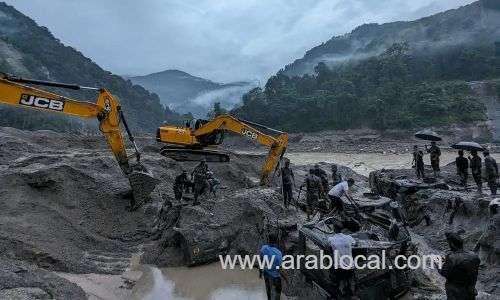
As of Saturday, a minimum of 56 individuals have been officially reported as deceased in the floods that have struck the northeastern region of India. The army has issued a warning that the flooding has carried away munitions, presenting a significant public safety concern.
Sikkim state was hit by violent torrents on Wednesday, triggered by the sudden rupture of a high-altitude glacial lake. Climate scientists are cautioning that such calamities are likely to escalate in the Himalayan region as global temperatures rise and ice continues to melt.
According to Anilraj Rai, the state relief commissioner, 26 bodies have been discovered in Sikkim thus far, and an additional 30 bodies have been retrieved from the Teesta river basin in the neighboring West Bengal state by search and rescue teams. This river stretches up to 86 kilometers, and the search operation is ongoing.
Among the casualties are seven Indian army soldiers stationed in Sikkim, a region located on India's remote frontiers with Nepal and China, where a substantial military presence is maintained. Over 100 people, including 16 soldiers, remain unaccounted for.
India's defense ministry has stated that the floods washed away "firearms and explosives" from military camps, prompting the army to establish lookout teams along the river to recover loose ordnance.
Local media reports from Friday indicated that two individuals were killed and four others injured when a mortar shell exploded in floodwaters in West Bengal.
The flooding has caused extensive damage to roads, bridges, and telephone lines in the affected areas, making evacuations and communication with those cut off from the rest of the country challenging. According to the latest bulletin from the Sikkim government, more than 1,200 houses have been damaged by the floods. Over 2,400 people have been rescued, and nearly 7,000 others have sought shelter in makeshift relief camps set up in schools, government offices, and guesthouses.
The surge of water occurred when heavy rainfall led to the rupture of the high-altitude Lhonak Lake, situated at the base of a glacier near Kangchenjunga, the world's third-highest mountain. This added to the already swollen river, resulting from monsoon rains, causing damage to a dam and sweeping away houses.
Himalayan glaciers are melting at an accelerated rate due to climate change, leaving communities vulnerable to unpredictable and costly disasters, as indicated by research from the International Centre for Integrated Mountain Development (ICIMOD). Climate change specialist Arun Bhakta Shrestha from ICIMOD emphasized that the root cause of such events is climate change and that they are likely to become more frequent in the future.
Earth's average surface temperature has risen by nearly 1.2 degrees Celsius since pre-industrial times, but high-mountain regions around the world have experienced double that rate of warming, according to climate scientists.